Dear 50 penny coins.
Numismatists know that 2003 coins are not easy to get. Issued in a small print run, they have become valuable prey for numismatists. In the circle of collectors, rare exhibits that exist in a limited number are always of particular importance. The secret of their importance lies not in age, not in special artistic performance, not in a high degree of preservation, namely, that they are few. Therefore, the coins of 2003 are in demand among numismatists-weather experts, as well as among amateurs to collect exclusive copies.
Rare coins of 2003 release do not need to be popularized among specialists, because knowledge allows them to navigate among the mass of metal money and to distinguish rare copies from common ones. In the hands of the average man, the coin will be just a means of payment, because he is not interested in either the circulation of the coin or the origin. Against this background, the action of Yekaterinburg SKB Bank is perplexing. For what purpose was it carried out: to advertise a bank or, after all, coins?
The action was called “The Ruble - for five thousand!”, Its launch took place in mid-January 2011. SKB Bank has announced that it will redeem 2003 coins for 5,000 rubles. per copy, regardless of face value. Throughout the Russian Federation, residents began feverishly sorting through the contents of their wallets. Fortune smiled at the cashiers, drivers, owners of piggy banks and people who work directly with money. The largest number of coins was exchanged in Moscow (155) and Sverdlovsk region (125), and only a few dozen were fortunate enough to find residents of other regions. According to some rumors, SKB Bank a tempting share cost 5 million rubles, which means that 1/15 of the circulation was bought up.
The remaining 14 thousand coins of 2003 are either in wallets or in collections of numismatists.
Coins of 2003 became popular and coveted, and SKB Bank gained fame as a beneficent financial institution. What was the purpose of the strange action? This is considered a trade secret, but some numismatists believe that the bank will pack the purchased copies in blisters with its own stamp and will sell them at exorbitant prices after a few years.
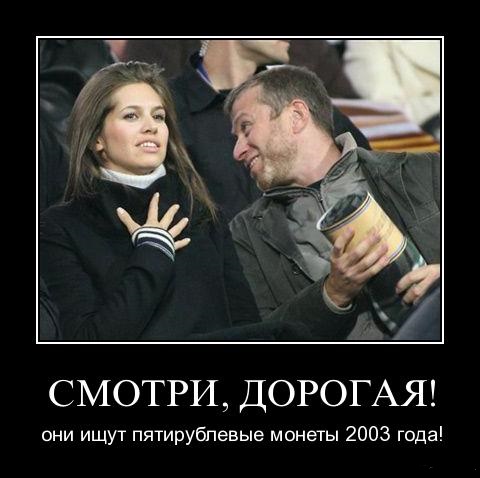
5000 rub. for one sample - good revenue, but the opinion of connoisseurs remains different. The chairman of the numismatist community, Vladimir Rykov, claims that the market value of the coins is two times higher than the proposed bank. How much are the unique coins of 2003 and how are they remarkable?
This money is in free circulation, so the likelihood of its detection is quite high. Fifteen thousand copies fell into two Russian regions, and from there it spread throughout the territory of the Russian Federation. The history of coins is simple: there were a number of circumstances that did not allow to issue more new coins, as there simply was no need for it.
After the denomination of the coin in denominations of 1 ruble, 2 rubles and 5 rubles underwent a number of minor changes. Prior to this, metallic money of the same denomination in 1997 was used, but in 2002 their reverse began to look different. On the reverse of 1997, over the heads of the eagle was a semicircular inscription “BANK OF RUSSIA”, and below, under the image of the eagle, the face value was indicated in a straight line. The denomination is underlined by a straight line, and under it is the year of manufacture.
On the coins of the new sample, the denomination and designation of the bank were reversed: the denomination is indicated above the eagle in the form of a semicircular inscription, and “BANK OF RUSSIA” (semicircle) is located under the eagle. Below is a straight line, separated by a dot, below it is the year of issue. Since the issue of coins was planned for next year, the inscription under the straight line is “2003”. Minor changes were mainly visible only to the collector's eye.
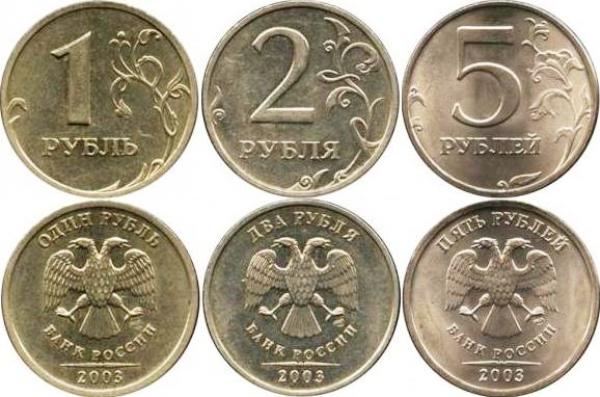
Amendments were made in 2002, and new coins were produced by the Moscow and St. Petersburg mints specifically for numismatic sets. Valuable coins of 2003 were minted only for sets, because the Central Bank of Russia did not plan to issue coins in denominations of 1 ruble, 2 ruble, and 5 rubles in 2003. The St. Petersburg Mint annually minted coins for sets, so 2003 editions were ordered as an exception. Collection-type coins are designed for numismatic sets, but for unknown reasons, sets are not formed. Coins fell into free circulation, from where they were seized by collectors. To date, the cost of each instance is at least 100 times the face value.
Coins were issued by the St. Petersburg and Moscow mints, but St. Petersburg specimens have special value. The mint icon is located 2-3 mm below the left paw of the eagle, on the reverse. The coin is made of steel plated with cupronickel. A penny made by MMD costs up to 300 rubles; a similar copy performed by SPMD costs 700-2000 rubles. depending on the degree of preservation.
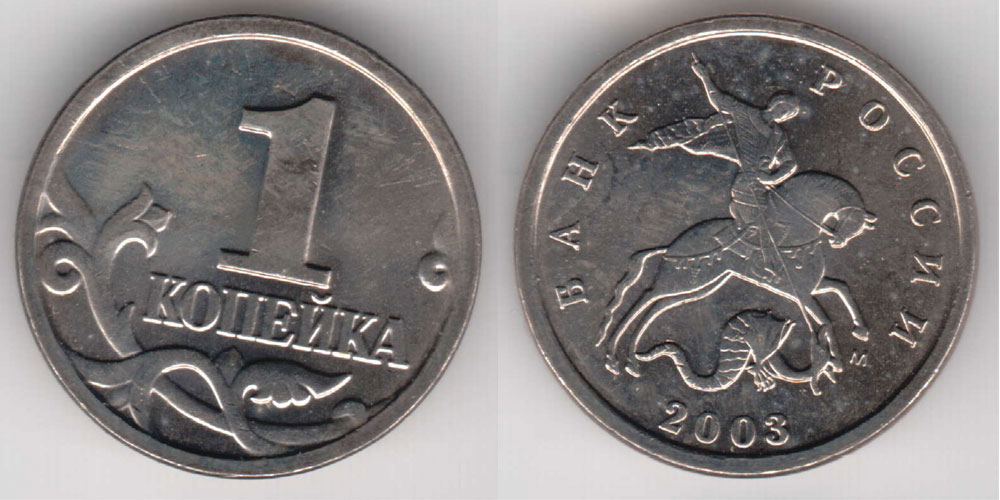
MMD issued coins with George the Victorious on the reverse, and SPMD with a double-headed eagle. A wide edging has become an invariable attribute of a coin worth 1 kopek.
The coin is not a rarity for collectors-numizats, and its cost ranges from 200 to 2500 rubles. depending on the mint and quality. There are rare instances in which there is no image of the mint. The price of such a coin will be 18,000 rubles.
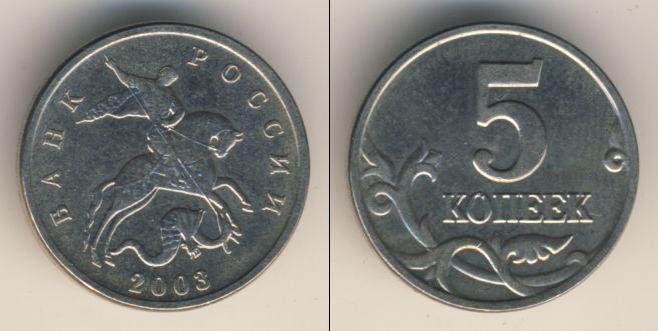
10 kopecks 2003
The coin is made of brass alloy. It was produced both by the Moscow Mint and St. Petersburg. The maximum value of a coin in good condition does not exceed 2000 rubles. Exceptions are rare varieties of coins. For example, with a thick letter "o" in the word "cents", with a bottom sheet on the obverse, distant from the edging, with thin letters "S.-P." etc.
Currently, as part of numismatic auctions, you can see a 50-cent coin of 1997. This brass kruglyash, which is not distinguished in any way, has a very important historical significance: it was from him that a penny fifty rubles began to revive in the Russian turnover, which practically disappeared after the collapse of the USSR.
Moreover, not only common variants of the banknote are known, but also its special “defective” varieties. About what value are rare varieties of 50 kopecks in 1997 in the framework of the auction - read in this article.
External characteristics of the coin
After the collapse of the Soviet Union, a coin in denominations of 50 kopecks was issued in Russia only once - in 1991. Then saw the light of the coin, the weight of each of which was only 2.2 grams. After that, for 6 years, fifty kopecks in the Russian Federation were not minted.
The issue of the “revived” 50 kopek coin was dealt with by both Russian mints. As a result, a significant number of fifty dollars turned out to be in circulation (the exact circulation is unknown) with the designations “M” and “SP”.

Among the main external characteristics of the metal fines emitted in 1997 are:
- The image of George the Victorious (the mint icon can be seen under the horse’s hoof), the inscription “Bank of Russia” and the year of the coinage - on the obverse;
- Placement of face value, name of coin and plant curls - on the reverse;
- The banknote edge has 105 corrugations, which has become an invariable tradition for all coins of the same denomination in subsequent years of minting - up to the present;
- Billets of 50 kopecks in 1997 were cast in brass, which is why the coins minted on them have a light, slightly golden tint;
- The mass of the brass coin is 2.9 grams, and its diameter is 19.5 mm. These characteristics are also repeated at all penny fifty years later.
About varieties of 50 kopecks 1997
Russian numismatic catalogs do not contain information about varieties of a penny fifty kopeck of 1997 mint. However, at auctions you can find coins of the most varied quality: from F (good) to UNC (not previously in circulation - uncirculated).
So hello again! Our conversation about the coins of the modern Russian Federation, and more precisely about its most valuable representatives, continues. The culprit of this article boasts a cost of approximately 100 thousand Russian rubles. Agree, the cost is far from small, and everyone will be happy with such a find! A small coin, and the price is very large, we are talking about valuable coins of Russia 50 kopecks.
Now about the coin itself. Maybe some have already guessed, but for those who have not yet understood, we will talk about a 2001 coin with a face value of fifty cents. It is minted by the Moscow Mint (mmm) and its circulation is currently not known. But the huge cost is known, which, according to some estimates, even exceeds 100 thousand rubles, reaching 120 thousand. Finding such happiness is not easy, but who knows, maybe you are lucky!
Of course, for a coin to be accepted at such a high price, it must be in perfect condition, with any scratches or other external defects, the price will be reduced. The only condition is that the coin must be struck precisely by the MMD (Moscow Mint).
Be vigilant - fake!
The coin is very rare and valuable and, as a result, some clever people try to fake it. Fakes are very easy to detect. Fraudsters often sell such coins at auctions, because people are sure that only really rare and unique things are at the auction, and it’s not so easy to check at the place where everyone is making noise and arguing. To notice a fake coin, you need to know how it is made. Coin fraudsters in 2007 with the same denomination accurately interrupt the number seven so that it matches the unit. The fake is ready.
Why is the coin of 50 cents 2001 rare?
Yes, because this coin, strictly speaking, appeared out of nowhere (in fact, like one ruble in 2001). Officially, it was not minted. A small number of its copies were nevertheless released for unknown reasons and, as a result, are now of great value. Now these coins are rare, that is a rarity, therefore the cost is so high.
Rumors about the great value of the coin of 50 kopecks in 2003 excite: its value is allegedly torn to sky-high heights. Where did such assumptions come from?
In 2003, ruble coins were minted in a limited edition, and therefore received the status of “rare”. Some beginners automatically extended the value to 50-kopeck coins of the same year of issue. Knowing that, the owners of fifty dollars began to offer them over the Internet for an impressive amount.
Other experts are sure that this is a completely ordinary coin, meaning nothing to the numismatist. Both of them are wrong: in fact, as many as seven varieties of fifty dollars born in 2003 roam the world : standard and six deviations from it.
Cost
Tagan price tag for 2017: 10 - 500 rubles
Specifications
| Year | 2003 |
| Face value | 50 kopecks |
| Mint, designation | Moscow Mint (MMD), St. Petersburg Mint (SPMD) |
| Obverse |
|
| Reverse |
|
| Metal, test | Brass alloy |
| Release period | 2003 - present |
| Weight | 2.9 g |
| Thickness | 1.5 mm |
| Diameter | 24 mm |
| Hert | Ribbed (105 corrugations) |
| Circulation | unknown |
Varieties
The obverse for the entire circulation of coins was made perfectly: neither the MMD nor the SPMD allowed even the slightest inaccuracies. Unlike its counterparts of a later generation - since 2006, steel lacquered with brass began to be used for this purpose.
With reverse, the numismatists were more fortunate. Moreover, their mint of St. Petersburg pampered: MMD was not noticed in any liberties - its entire circulation corresponds to the standard.
In total there are 6 options for inconsistencies with the ideal - they determine the price per copy. Let's consider them in more detail.
Variety number 1
The inner lines of zero are curved, the top bud of the twig does not touch the five, the bottom is large: such a coin is extremely rare, and it costs 500 rubles. The price, however, has not settled down to this time, it depends on bidding at auction.
Variety number 2
The second variant of minting differs from the previous one by the presence of touching the bud of the five, and the bottom sheet is in contact with the edging, the border of the coin is thick.
Variety number 3
The next variety is characterized by a thin edging, open to the left of the sheet. The leaf and the edging do not touch.
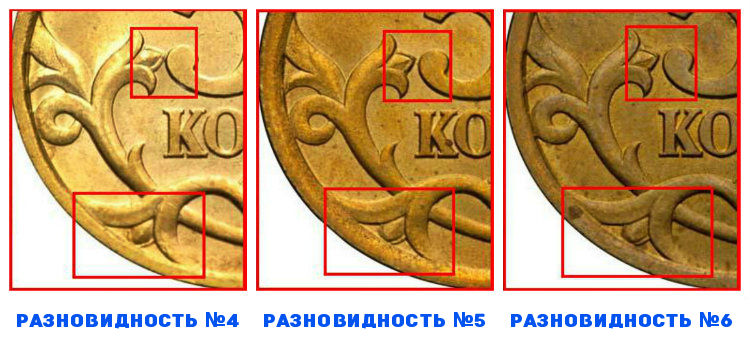
Variety number 4
Another variation: the edging is cut off at the bottom of the obverse, the letters “P” and “E” are placed at a closer distance.
Variety number 5
The numbers "5" and "0" are shifted closely, the edging and the sheet are more rounded.
Variety number 6
The numbers "5" and "0" are shifted, but the gap between them remains, the bottom sheet touches the edging.
The cost of varieties No. 2, No. 3, No. 4 does not rise above 20 rubles.
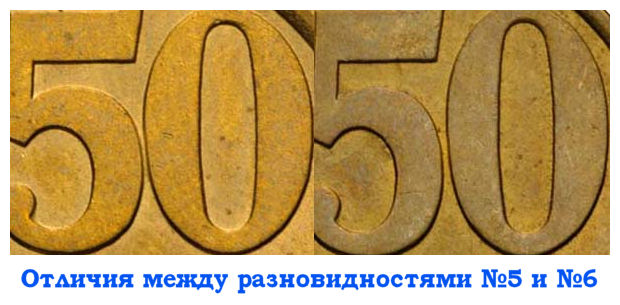 The fifth and sixth varieties are variations of the first, therefore they are subject to a rather high price.
The fifth and sixth varieties are variations of the first, therefore they are subject to a rather high price.
MMD coins can be sold for 10 rubles, but on condition that they have exceptional safety. If on their surface there are nicks, scuffs and other damage characteristic of coins that have been in heavy use, then their price corresponds to the face value.
I must say that it is not always possible to sell expensively even the rarest coins of 50 kopecks in 2003: their cost depends on many third-party factors. The number of auction participants interested in acquiring, even the trading platform on which the auction is organized, is all reflected in the final price. An important role is played by the technical condition of the coin.
The cost of 50 kopecks of 1922 in Russia varies within from 958 to 1,278 rubles. In addition, it is worth mentioning immediately one feature of calculating the current value of a coin in relation to existing international standards for assessing the condition of coins. Based on their regulation, the current price of 50 kopecks in 1922 is within 63 880 rubles. It is exclusively about coins in the Uncirculated state (excellent condition).
Chasing 50 kopecks with a smooth edge
Among the total number of copies there were 50 kopecks with a smooth edge. This is a rather rare coinage of a limited edition. Tactilely different from the above, devoid of roughness around the perimeter. Everything else, including visual similarity, is identical to the other 50 kopecks, circulation of 1922. Its price is within from 38,000 to 44,000 rubles, subject to compliance with the Uncirculated parameters.
Coin specifications
As a metal for minting a circulation of coins with a face value of 50 kopecks in 1922, silver of 900 and 500 tests was used. The usual workmanship made it possible to create the then currency unit with a diameter of 26.67 mm and a mass of 10 g.
It is worth noting immediately that this face value, made of 500 samples, is very limited and is also a real find for a true collector. The number of print runs even now remains unknown. The owners of this coin note some differences in diameter and weight, namely 25.5 mm and 10.1 g, respectively. 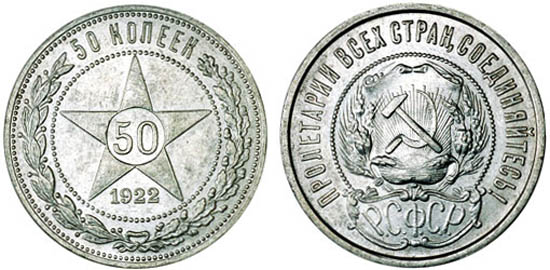
How to get this coin?
The indicated prices are relevant for the current state with the Uncirculated mark. Sale / purchase of 50 kopecks is usually held at open / closed auctions. What is the difference between the latter? As a rule, open bidding is accompanied by a short registration, which does not require general information about the collection and the purpose of buying a coin of the indicated denomination. Closed, on the contrary, are accompanied by a huge amount of information, not necessarily reliable. It is also worth noting the possibility of withdrawing a certain percentage for a perfect deal. The ability to purchase directly "from hand", also has not been canceled.
How to determine the value of the purchased coin?
The evaluation process is carried out in relation to the already mentioned system of standards for the international assessment of the state of coins. In the vast majority of cases, the assessment is made based on the degree of deterioration of the coin:
- The presence of scratches.
- Dents.
- Darkening.
The more such defects in the nominal value presented, the lower its cost. The amount of damage received during its use / storage, respectively, and the degree of accessibility of the minted image, affect the final cost that the collector will offer, arguing for one of the gradations of the current state:
- Uncirculated (gradations of international significance) - excellent (designations of domestic gradations).
- About Uncirculated - almost superb.
- Extremely Fine - Great.
- Very Fine - very good.
- Fine is good.
- Very Good - Satisfactory.
- Good is weak.
With each gradation, the value of a coin decreases by several thousand rubles. Finding this face value in excellent condition is an unusual rarity. In this case, the opportunity to buy cannot be missed, as their number in free circulation can be equated to units whose condition is in great question. For a novice collector, the pursuit of excellent gradation, as a rule, is erroneous and completely ridiculous. 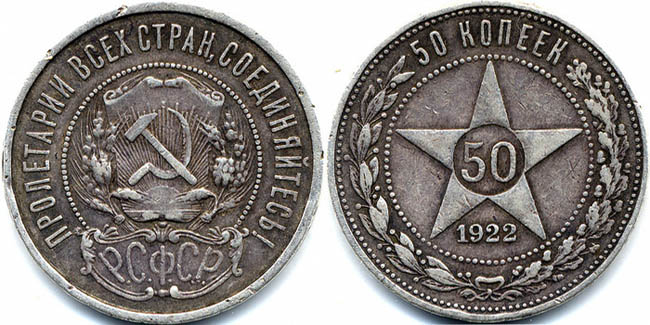
The extremely high price and the minimum chance to find this particular denomination - 50 kopecks in 1922, may turn out to be an unbearable burden.
Best to start with a satisfactory gradation! Thus, you can purchase a silver coin in denomination of 50 cents, both 500 and 900 samples. Price due to very low gradation must not exceed 4,000 rubles at any of the above auctions.
Attempts to self, and any other types of recovery, it is better to immediately exclude. The used metal - silver, which, in turn, after significant “rubbing”, will lose its natural luster - will darken.

